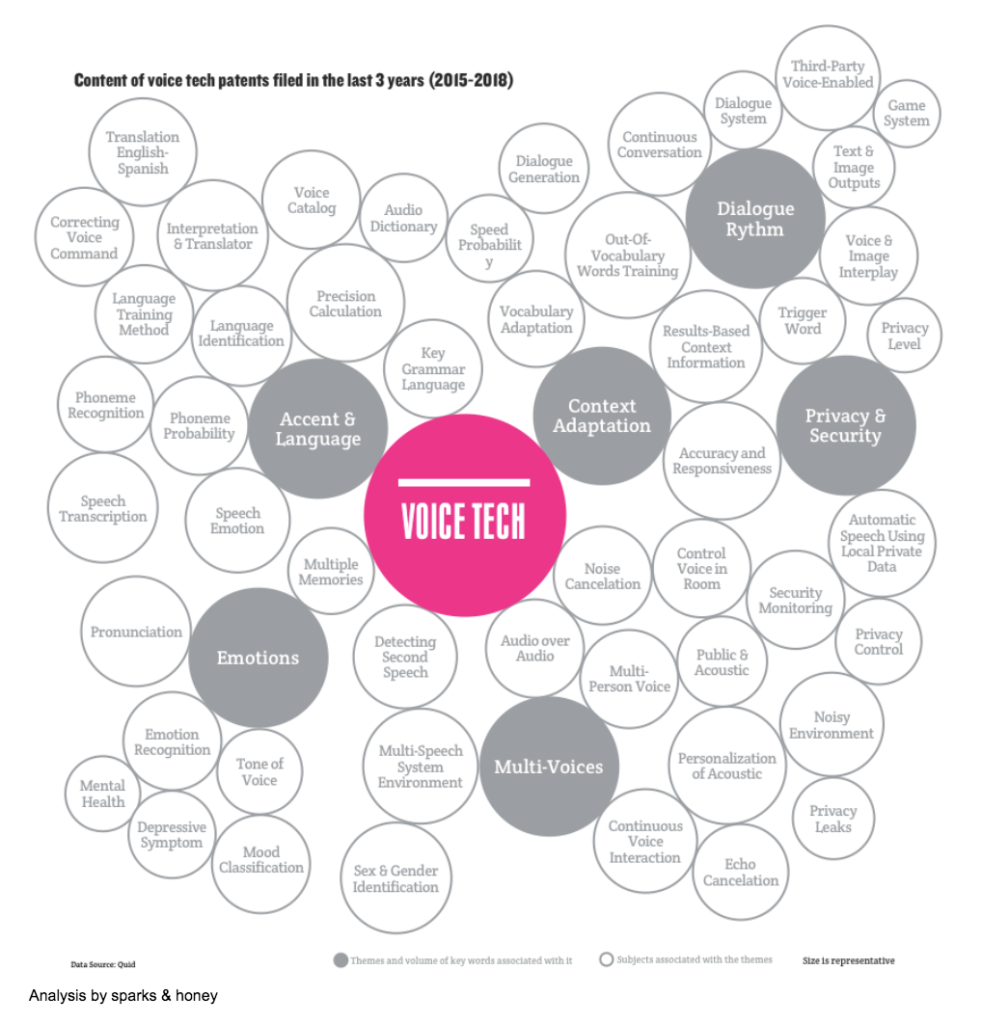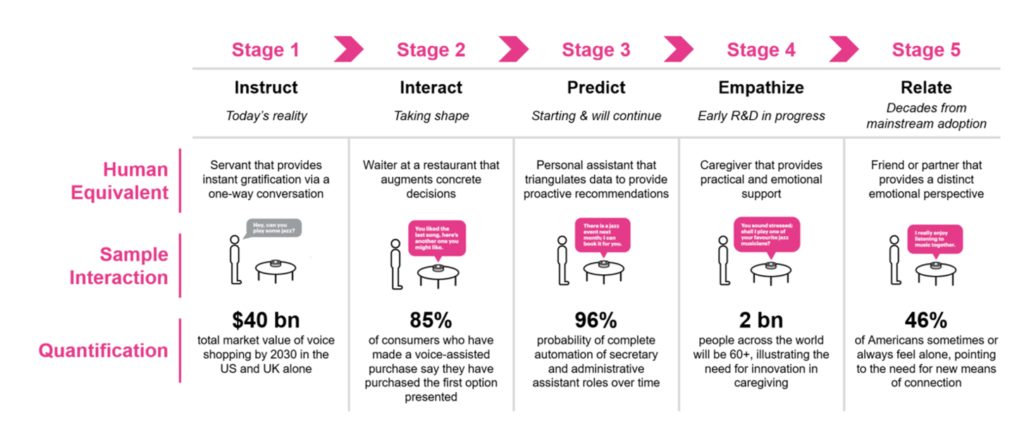
The consumer world is being overhauled, from how we access products, services, content and education to how we build relationships, both with each other and with the world around us, how we engage with the devices that power our every day, how we live in our homes, and how we discover.
What’s the force of innovation transforming how we live, in increasingly innumerable ways? Voice technology.
The technology itself is changing at an exponentially increasing rate. Early 20th-century research and development efforts at innovation hubs such as Bell Labs, IBM, Carnegie Mellon and DARPA have set the stage for the rapid proliferation of AI-powered voice technology platforms and devices over the last decade. These devices are now in our kitchens, workspaces and pockets.Innovators from Fortune 500 companies, cutting edge start-ups, academic institutions and other public sector organizations are pushing the limits of voice technology through the exploration of areas including accent and language, emotions, multi-voices and context adaptation. In addition, increasing numbers of industries, from messaging and gaming companies to education-focused organizations, biometrics companies and law enforcement, are applying for patents related to voice technology as they find ways to integrate it into their processes, remove friction and create more positive consumer outcomes.

Innovation in voice technology is happening in a culture where issues of security and privacy linger around any actions that individuals take in the digital world. As the technology gets smarter and more intuitive, and becomes embedded in an increasing number of devices and spaces that we interact with on a daily basis, so does our relationship with it. Its role in our lives has changed over time, and will continue to do so in ways we only recently could have imagined. We have established the five foundational stages of the evolution of voice technology in that context.

1. Instruct
As modern-day voice technology began to take shape in the late 2000s, we entered into what we call the “instruct” phase in the evolution of this technology. This is the type of relationship that many users have with their home device or digital assistant. We ask it to play a specific song, to order a particular item for the pantry, to answer that question we just can’t remember, and so much more.
We see our voice tech-driven devices as we would a servant, providing instant gratification and satisfying one’s curiosity. A study by Accenture revealed that 52% of consumers trust intelligent devices to shop for food, while 49% trust them to shop for other items such as clothing and accessories. Furthermore, the projected $40 billion market for voice tech-driven purchases in the UK and US by 2022 illustrates just how much this “instruct” relationship will continue to impact our everyday consumption routines.
2. Interact
We currently find ourselves in the second stage of this evolution, which we call the “interact” phase. We are treating our voice assistants more like a waiter – someone who has the ability to take our order, identify patterns in one’s ordering and offer up suggestions that augment the human decision-making process. It makes recommendations rather than just takes orders. Technology leaders such as Amazon and Google are filing new patents designed to monitor more effectively what we say and do in order to serve up better recommendations and more relevant advertising and offers through their voice platforms. This trend for more precision-based, personalized recommendation engines driven by voice tech will only continue.
3. Predict
Soon, we will start to see voice-driven AI increasingly able to recognize your emerging needs before you do. It will proactively ask whether you want to refill your soon-to-be-depleted product, reflect things like weather shifts in recommendations, and more. We refer to this as the “predict” phase in our relationship with voice technology.
A futuristic scene from the film Minority Report comes to mind, in which a virtual shop assistant pops up in real-time to make recommendations to Tom Cruise, based on past purchases, as he walks through a Gap store. This kind of scenario is already starting to take shape. Its precision will rapidly increase and, accordingly, consumers’ embrace of it.
4. Empathize
The next phase in the process is when things start to get serious between humans and their voice AI companions. This iteration of the technology acts almost like a caregiver, flagging potential health issues based on the nuances of one’s voice, using emotion recognition and biometric monitoring. The voice AI may recommend a glass of water if one sounds thirsty, or a moment of zen if one sounds stressed out. Amazon, for example, has recently filed a patent related to detecting physical and emotional well-being based on voice tech interactions.
We also are trusting these devices with helping to care for our children. Accenture studies show that 39% of consumers trust intelligent devices to monitor babies and children, and make adjustments to surroundings based on comfort or security. There are also implications for caring for older cohorts. Two billion people globally will be over the age of 60 by 2050, and with this massive demographic shift will come increased demands that human caregivers may not be able to meet alone. Voice technology will likely play an increased role in caring for the world’s ageing population.
5. Relate
Finally, we will reach the full-blown “relationship” phase. Films such as Her and Blade Runner 2049 show the types of deep, emotional interactions we may eventually have with voice tech-led AI technology. We will see voice AI as a friend or even a partner, and we will share our emotions with it.
For some, a voice AI companion will be a supplemental connection to their human relationships, while for others, voice AI may become their predominant and grounding relationship. In research by Cigna, nearly half of Americans report experiencing feelings of loneliness. This trend is most pronounced among younger generations – Gen Z and millennials. With the increasing global loneliness epidemic, there is a growing opportunity for voice AI to fill this void and provide companionship to those who lack it.
Today’s situation, where the relationship between voice and consumer is largely transactional, barely scratches the surface of possibility. All this will change sooner than we think. Voice technology has the potential to touch multiple dimensions of consumers’ day-to-day lives – and markedly, because it can so easily address enduring and underlying consumer needs with a very human experience. While we can see a very positive place for this technology to enhance consumer well-being, there are also extremely real and serious implications for consumer privacy which governments, research organizations, technology developers and industry players will need to work together to address.
Article Credit:We Forum
